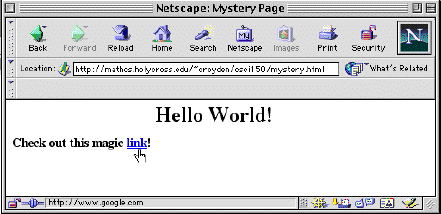
CSCI 150, Spring 2003
Home | | Course Schedule | | Assignments | | Lecture NotesThe following topics have been covered in the final part of the course. Each of the following topics may appear on the exam. In addition there may be questions on any of the topics covered in the earlier parts of the course.
1. Machine Architecture Computer organization CPU with registers (IP, IR, CF, AX) Memory P88 Assembly language (you do not need to memorize the instructions, but you should understand how to use the instructions to write a program) Fetch Execute cycle Language Translation 2. History of the Internet Origin of the internet--ARPAnet. How the internet evolved Organizations that oversee the internet 3. TCP/IP Protocols--Purpose, types of protocols (TCP/IP, HTTP, FTP) Packet Switching Function of TCP and IP in sending and receiving email How email is transmitted across the network. 4. The World Wide Web Definition of World Wide Web (difference from Internet) Purpose of Hypertext The Client/Server Model Universal Resource Locators 5. Hypertext Markup Language (HTML) Standard form of an HTML file Common HTML tags (as listed in course notes) Adding Images, Links and Graphics to your page Absolute vs. Relative addressing Coloring the background of your page HTML Tables 6. Web Graphics Monitor resolution and image size Color representations Bit Depth Color Tables RGB Hexadecimal Color notation Graphic File compression (GIF and JPEG) 7. Tractable and Intractable problems Definition of tractable and intractable problems Examples of Intractable Problems (e.g. Tower of Hanoi or Traveling Salesman). 8. Noncomputability Countable and non-countable sets Non-computable functions The halting problem Other non-computable problems
Practice Problems
The following problems are intended to help you study for the exam. In addition, you should
review the problems from the first two review sheets, along with your homework and labs.
1. Use the web page screen shot given in Figure 1 to answer the following questions. This shot was taken when the mouse was over the link.

Figure 1. Screen shot of web page for problem 1
b. What is the title of the web page?
c. Where does the link go?
d. What is the name of the web server that this page is served from?
e. Write the HTML file that would generate this page. Hint: Headlines of size 1 and 3 are in this page.
2. The following equations give the running times (t) of different algorithms with respect to the size of the input (n). For each, state whether the problem is tractable or intractable:

3. The following table gives the running time of an algorithm for different input sizes:
Size time(secs) 1 0.5 2 2.0 3 4.5 4 8 5 12.5 ... ... 10 50 100 5000
b) Based on the values given, do you think this algorithm is tractable or intractable? Why?
4. Protocols.
b) List three protocols that we covered in class, and briefly state their functions.
5. What color does #FF00FF represent in the RGB color representation?
6. Suppose an image file has a bit depth of 8, a width of 100 pixels and a height of 200 pixels.
b) What is the size of the image if displayed on a monitor with a resolution of 50 ppi (pixels per inch)?
7. Briefly describe what "packet switching" means and how it is used on the internet.
8. Describe how we know that some functions are non-computable. Describe 2 problems that are non-computable.
9. Suppose you want to prove that a given problem was non-computable with a proof by contradiction. What are the 2 steps you must accomplish for such a proof?
10. Write an assembly language (P88 instructions) to read in two numbers. If the first is bigger, it should print out the first number. Otherwise the program should print nothing and end.
11. Write a pascal program to read in integers into an array until a -1 is entered. Count the number of 2's entered and print out the result.
program twoCounter;
type
intArray : array[1 . . 100] of integer;
var
myNumbers: intArray;
{Add your variables here.}
begin
{Add your pascal code here.}